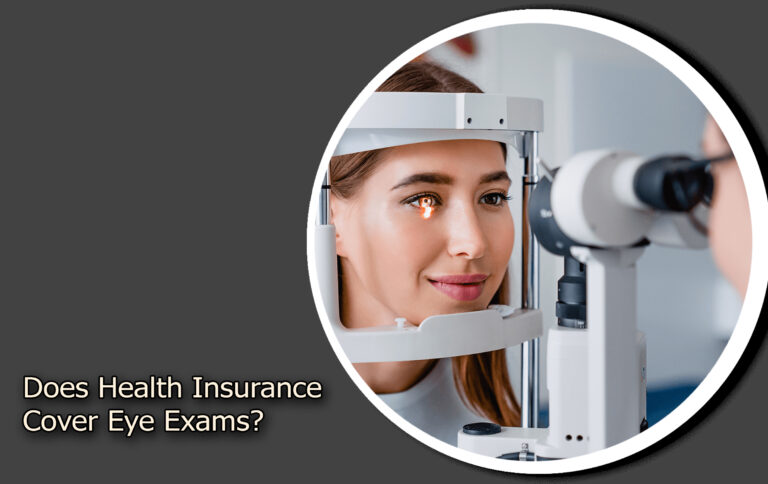
Does health insurance cover eye exams? Eye health is an important part of our overall well-being, yet somehow, it receives even less attention than other medical needs.

Eye exams are not only important for maintaining good vision and ticking the box that all is well. It’s also crucial for detecting underlying health conditions such as diabetes, high blood pressure, and glaucoma.
Many individuals assume that their standard health insurance plan covers all forms of healthcare, including vision care. Unfortunately, this is not always the case.
Whether you’re seeking routine check-ups or screenings for more serious eye conditions, it’s important to understand what your health insurance plan does and does not cover.
In most cases, traditional health insurance plans offer limited coverage when it comes to routine vision services like annual eye exams, eyeglasses, and contact lenses.
Instead, vision care is often managed through separate vision insurance or discount programs. However, there are some exceptions; especially when an eye exam is deemed medically necessary.
Understanding the distinction between routine and medical eye care is essential to knowing what is covered and what may require an out-of-pocket expense or a supplemental insurance plan.
The Basics of Health Insurance and Vision Care
When it comes to considering whether health insurance covers eye exams, one thing you must understand is the difference between vision insurance and health insurance.
The traditional health insurance plans primarily focus on diagnosing and treating medical conditions, whereas routine eye exams are often viewed as preventive or elective services.
What’s more, health insurance may cover eye exams only if they are related to a medical issue. For instance, if you have symptoms such as blurry vision due to a health condition like diabetes or an eye injury, your health insurance may cover an eye exam as part of diagnosing or treating that condition.
On the other hand, if you’re getting a routine eye exam to update your prescription for glasses or contact lenses, you’ll likely need a separate vision insurance to cover that cost.
Features The Traditional Health Insurance covers
Here are some of the features that the traditional health insurance may cover:
- Eye exams related to diagnosing or managing a medical condition
- Eye injuries or infections
- Exams necessary for managing chronic diseases such as diabetes or hypertension
On the other hand, here are features the health insurance usually does not cover:
- Routine vision exams for glasses or contacts
- Prescription eyeglasses or contact lenses
- LASIK or other refractive surgeries unless it is medically necessary
What is Vision Insurance and What Does It Cover?
Vision insurance is a separate plan that is specifically designed to handle eye care needs that are not considered medically necessary. Also, it is often offered as an optional benefit through employers or as an add-on to your individual health insurance plan.
Furthermore, the vision insurance focuses on preventive care and maintenance of eye health. The cost of routine eye exams, frames, lenses, and contact lenses is often either fully covered or offered at a discounted rate under vision insurance plans.
Some of the common vision insurance benefits include:
- Annual or biannual eye exams
- Eyeglass lenses and frames
- Discounts on corrective surgeries like LASIK
- Contact lens fittings and allowances
However, it is important to know that while these are the benefits mentioned. Not all vision insurance policies are the same. Some may offer broader benefits while others provide only basic coverage.
When Does Health Insurance Cover Eye Exams?
There are specific scenarios in which your general health insurance will cover the cost of an eye exam. This usually happens when the eye exam is part of diagnosing or treating a medical issue, not for vision correction. Some sections where the coverage applies include:
- Eye infections or diseases (e.g., pink eye, glaucoma)
- Post-surgical care following eye surgery
- Symptoms like sudden vision loss, floaters, or flashing lights
- Monitoring eye health for conditions like diabetes or high blood pressure
In such cases, the eye exam is coded as a medical visit rather than a routine vision check, allowing it to be processed under your health insurance. However, it’s very important to know that even when covered, you may still have to pay a co-pay, meet your deductible, or follow other cost-sharing requirements.
How to Check What Your Plan Covers
Before you scheduling an eye exam, it’s important to confirm whether it will be covered by your insurance provider. You can do this by reviewing your insurance policy or contacting your provider directly.
Here are some of the steps you can take:
- Read your benefits summary and look under both medical and vision coverage sections.
- You can contact customer service to ask specific questions about what is covered under your plan and under what circumstances.
- Also, you can check your provider network. You can do this to make sure the optometrist or ophthalmologist you choose is within your insurance network to avoid additional costs.
Sometimes, your eye doctor can tell you which exam codes will be submitted. And whether those are typically covered by insurance.